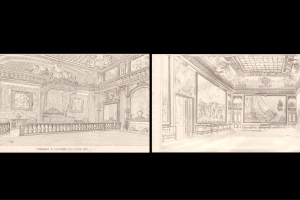In The Weight of Things I animate two 19th century etchings of two rooms in the Versailles Palace. The animated rooms to appear as if they are in midst of an earthquake. One-by-one, the many elements of the densely decorated rooms tremble and fall to the floor. The maximalist Baroque art and decoration, falls away to the stark minimalism of empty rooms.
The destruction of the rooms depicts civilization in decline. The disasters remind us that anything that we build, no matter how much money we put into it, can be torn down by one uncontrollable event. “The Weight of Things” implies that all of these objects carry the weight of their origins and the destruction of all that stood in the way of the process of acquiring them. The work lays bare the fragility of the earth, it’s inhabitants and the systems that we create to reinforce the accumulation of wealth and power. Often, we sacrifice the earth for these things and the earth will someday reclaim all that we have taken from it.
Charlene Stevens Whitehot Magazine review February 2019. Israeli born New York artist Dana Levy’s two-channel video installation, The Weight of Things, at Fridman Gallery is a work of art that must be experienced. The audio track of the rumblings of actual earthquakes allow the viewer to feel the vibrations of the earthquake depicted in the video. Sitting in the basement-level media room allows the viewer to feel not only the vibrations of the soundtrack, but also the subtle vibrations of the subway below one’s feet.
Levy’s source material, 19th century etchings of two rooms at the Palace of Versailles – the bedroom of Luis XIV and the Salle of Constantine, reduce the vibrantly colored opulent chambers, to outlines that are further reduced to piles of rubble. Watching the clearing of the rooms gives the viewer a sense of purification that one feels when watching a team of professionals clear out a hoarder’s house, revealing walls and floors hidden for years, or when Marie Kondo comes in and makes people organize their own homes. The maximalist Baroque art and decoration, further maximized by the Rococo, falls away to the stark minimalism of empty rooms and there is a feeling of relief when the earthquake purifies them.
Levy animates the elements of the room with a sense of humor. The labor-intensive separation and animation of the room’s elements consumed the Levy’s life for the good part of a year. When the rumbling begins, pieces of the room shake and almost dance. Figures in the paintings move independently of other figures and their backgrounds. The objects and architectural images have a life of their own until that life is extinguished with their fall.
The destruction of the rooms depicts civilization in decline. Our decline will not be punctuated by one catastrophic event, but by many disasters – natural and man-made. The disasters remind us that anything that we build, no matter how much money we put into it, can be torn down by one uncontrollable event. As I observe the destruction on a loop, my mind goes to great catastrophic events such as the burning of Rome under Nero’s reign and the destruction of Pompeii after the eruption of Mt. Vesuvius.
The Salle de Constantine, with its art that celebrates military expansion and conquest reminds the viewer that the wealth that sustained the monarchy and built Versailles was accumulated by means of the destruction of other civilizations and the lives of the those within. The
The emphasis on wealth and excess make me think of Lauren Greenfield’s, Generation Wealth, and it’s focus on the accumulation of wealth for wealth’s sake and income inequality. “It’s not the Birkin bags or the Kardashians. It’s about the culture that gave rise them.”[1] This culture was not resolved with the French Revolution that removed Luis XVI Marie Antoinette from Versailles. The players changed as the game continued as France sought to invade, colonize and subjugate around the globe.
The Weight of Things implies that all of these objects carry the weight of their origins and the destruction of all that stood in the way of the process of acquiring them. The work lays bare the fragility of the earth, it’s human inhabitants and the systems that we create and maintain that reinforce the accumulation of wealth and power. Often, we sacrifice the earth for these things and the earth will someday reclaim all that we have taken from it.

